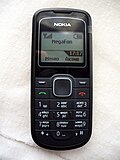 Nokia 1202 with the Arabic UI and keypad, active on the German O2 carrier. | |
| Manufacturer | Nokia |
|---|---|
| First released | November 2008 [1] |
| Discontinued | Yes |
| Predecessor | Nokia 1112 Nokia 1200 Nokia 1201 |
| Successor | Nokia 1280 |
| Related | Nokia 1203 |
| Compatible networks | 2G: GSM 900/1800 U.S. version: GSM 850/1900 |
| Form factor | Monoblock |
| Dimensions | 105.3 x 45 x 13.1 mm |
| Weight | 78 g |
| Operating system | S30 Software |
| Storage | 4 MB |
| Battery | Nokia BL-4C Li-Ion 720 mAh
|
| Display | 1.3", 96×68 pixels |
| Connectivity | Picture message support via Smart Messaging |
| Data inputs | alphanumeric keypad |
Nokia 1202 is a low-end GSM mobile phone made by Nokia under their Ultrabasic series, being aimed at first-time mobile phone users. It was announced in November 2008, and was released in April 2009. The phone was manufactured in Romania, India and China.

